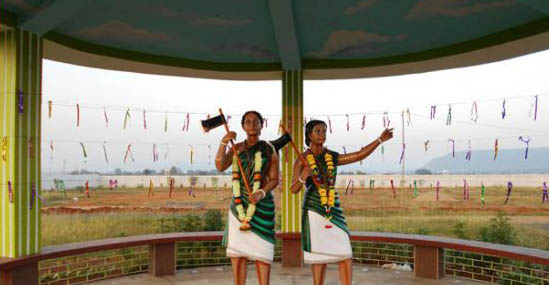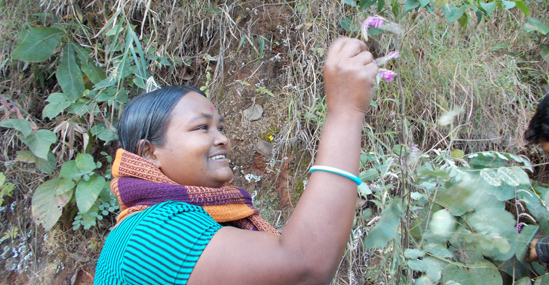

AK Pankaj
akpankaj@gmail.com
The world famous Santal Hul in 1855 is India’s first organized and well-planned revolution. This revolution started on 30 June 1855 from Bhognadih, a small village in Jharkhand. Bhognadih was under a special revenue area by the name of ‘Damin-i-Koh’, which was demarcated by the British in 1832 to stabilize the Santal settlement. According to British documents, Santals had come and brought for their livelihood and farming in ‘Damin-i-Koh’, which became ‘Santal Pargana’ after Hul of 1855-56. In 1838 around the boundary of Damin-i-Koh, there were only 40 Santal villages which increased to 1,473 in 1851. The population grew from 3,000 to 82,795. As a result the revenue from land also increased to 58,033 as against 6,682. Feudal-money and colonial plunder of the Santals’ unprecedented toil and hard work was behind the revenue that had multiplied 10 times within just 15 years.
The ‘Damin-i-Koh’ is that flat part of the land between the forests and the hills where the Paharia Adivasis, who did forest produce, hunting and a little shifting cultivation, were naturally living. Before Hul, in the Rajmahal area, the British first had to face the protests of these Paharia people. By adopting diplomacy, the British officer Cleveland changed the administrative-legal rules in the direction of making friendly relations with them and accepted their traditional self-governing system. Nevertheless, the Paharias continued to fight guerilla warfare under the leadership of Tilka Manjhi alias Jabra Paharia for complete independence. At the end of 1784, the British government was completely successful in suppressing the people of the hills, when they arrested Tilka on 13 January 1785 and publicly hanged him at the crossroads of Bhaglupar. For the next seven decades, the Santal Pargana remained an uninterrupted pasture for the plunder of the feudal moneylenders- and British officials. But on the last day of June 1855, when tens of thousands of Santals gathered in Bhognadih and with their support the Sido Pargana issued ‘Thakur ka Parwana’, the senses of British rule were blown away.
Before and after Hul, we do not find any account of such organized people revolution in Indian history, which was done with full preparation, public announcement and written information given to the ruling class by beating drums. The Sepoy Mutiny of 1857, which is said to be India’s first people’s revolt, began as a personal reaction and spontaneously. The Sepoy Mutiny or the Mutiny of 1857 was not well planned, well organized and well-publicized at all. Despite this, historians did not accept Santal Hul as the first Indian revolution, and this trend is still present in Indian historiography. Whereas in the past decades, there has been a substantial study and writing on Santal Hul in the country and around the world and it has been highlighted that Hul is the first proud page of the Indian Revolution.
Secondly, Santal Hul was not just a spontaneous movement against the ‘Mahajans and feudal exploitation. According to the available documents, it was a well-planned war against British rule. The preparations for which were done by Sido Murmu of Bhognadih village in unity with his brothers Kanhu, Chand and Bhairav, prominent Santal elders of the area, chieftains and other local artisan and farming communities like Paharia, Ahir, Lohar etc. When all of Hul’s tactical preparations were completed, troops, guerrilla units, military recruitment-training teams, intelligence teams, economic resource mobilization teams, logistics teams, propaganda teams, support teams, etc. were formed, carried out the strategic plan, then on June 30, a huge meeting was called and a ‘summon’ was issued to the British to leave the country. This summon i.e. ‘Parwana of Thakur’ was written by Kirta, Bhadu and Sunno Manjhi on the instructions of Sido Pargana. It is worth noting that Hul’s summons and other propaganda materials were written in three languages and different scripts. In Hindi, Bengali, Santali language and Kaithi and Bangla script. Not only this, new coins were issued especially by Hul’s fighters for economic activities, invalidating the British currency.
Issuing ‘Thakur ka Parwana’, Sido Murmu had said- ‘We are not fighting, this war is being fought by Thakur (the creator of Santals) himself, who has created this universe.’ Commissioner of Bhagalpur, Birbhum and District Magistrates and In the summons sent to the local police stations and other key officers, it was clearly stated- 1. Only the Santals have the right to collect the revenue. 2. For each buffalo-plough, Rs.2 will be charged annually, one ana for bullock-plough and half ana for cow-plough. 3. The rate of interest will be one paise per annum at Re. 4. The moneylenders, Mahajans and landlords will have to vacate this area immediately. 5. On the orders of ‘Thakur Jiu’ (Supreme God of the Santals), the rule of the Santals is restored over the entire region and now the Sido pargana is the head of the ‘Thakur Raj’. 6. All British officers and Thanedars are informed that they should immediately come and attend the court of Sido Pargana, otherwise strict action will be taken against them.
Obviously, the British rule was not ready to accept it. Therefore, as soon as the first week of July passed, the Santals and the local people made a ruckus. There were systematic attacks on the markets, the bases of the moneylenders, the police stations, the British district administrative headquarters and centers. It took many British troops to suppress this mass war which went on intensively till 1856, but Hul’s fighters fought intermittently but continuously till 1860-65 against the British Raj. 52 villages altogether and in total, more than 50000 people were directly involved in this historic Hul. Hundreds of Santals and people from other local communities were martyred in Hul, thousands fled the country and received sentences ranging from rigorous life imprisonment to partial prison torture. A large number of these were women, who were led by Phulo-Jhano etc. Most of whom we do not know the names of the heroes.
It is also known that very few people know that the chief strategist of Hul was not Sido but another Santal warrior Kolia alias Cherka Santal. On his arrest, the British government had kept the reward amount twice more than that of Sido Murmu. There was a reward of five thousand on Sido and ten thousand on Kolia Santal. Other than the Santals, the prominent people of other communities were Mangra Puzhar (Paharia), Goreya Puzhar (Paharia), Hardas Jamadar, Thakur Das, Bechu Rai (Ahir), Gandu Lohra, Man Singh, Gurucharan Das etc. were martyred in the first mass revolution or would have been sentenced to imprisonment. That is, people of all social groups living in Damin-i-Koh in Santal Hul were equal partners in the fight to overthrow the British. Therefore, the Santal Hul was not a spontaneous local revolt on a small scale. It was a declared and organized people war against the Mahajani system and the British rule. This was announced in writing and ‘Thakur ka Parwana’ (summons) were issued for the tyrants to leave the area and the British Raj to bow down to the Santals. In comparison, the Sepoy Mutiny of 1857 was a spontaneous one, in which the feudal lords and the Indian public at large later became involved. The result of this Hul is a change in the attitude of the administration and administration towards Adivasi rights, ‘Santal Pargana’ was formed as a special administrative unit and later the Santal Pargana Tenancy Act was enacted. Despite all these facts, if even today the historians of the country are not considering it as India’s first revolution or freedom struggle, then it will be called ‘historical injustice’ being done to Indian history.
Please Share and Support



